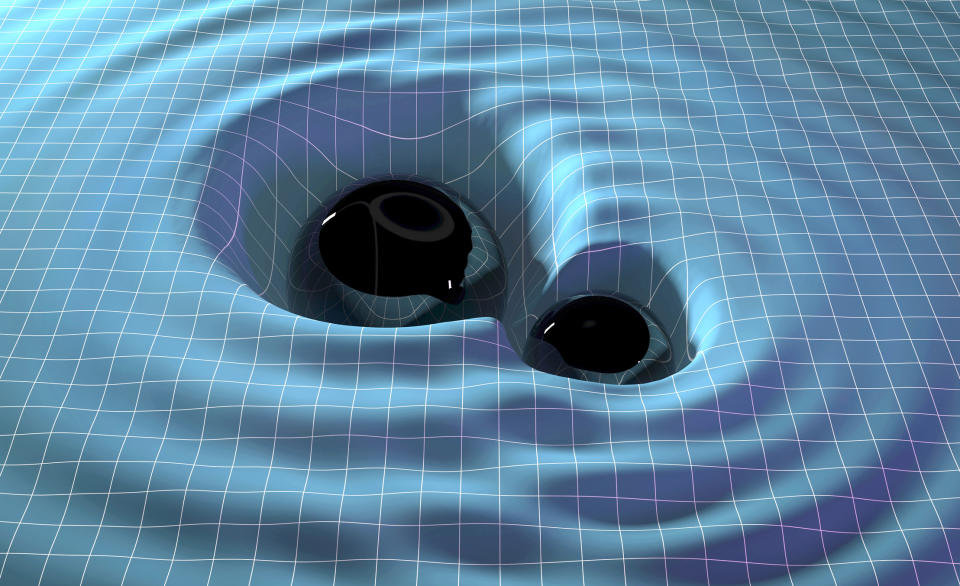Colliding black holes 'ring' across space-time with gravitational wave ripples

When black holes collide and merge to form even more massive black holes, this violent process sends ripples surging through the very fabric of space. A new model indicates how these gravitational waves interact with each other as they spread through space-time, the unification of space and time popularized by Albert Einstein's theory of special relativity.
By presenting a clearer picture of how black hole collisions set space-time "ringing," the model could indicate how scientists on Earth can learn more about the events that launch them using gravitational wave detectors such as the Laser Interferometer Gravitational-Wave Observatory (LIGO). LIGO made the first detection of gravitational waves from merging black holes in 2015, with the signal going on to be named GW150914.
Previously when physicists have modeled black hole mergers and the gravitational waves they send through space, they have only done so with linear mathematics, without considering how these waves influence or interact with each other as they propagate outwards. By taking these interactions into account, a team of researchers believes they can model black hole collisions greater in detail, revealing what are known as nonlinear effects and putting general relativity to the test when it comes to black holes.
Related: Black holes: Everything you need to know
The key to this new supercomputer model, created by the Simulating eXtreme Spacetimes (SXS) team, is simulating these collisions and gravitational waves in more detail to reveal these non-linear effects.
"Nonlinear effects are what happens when waves on the beach crest and crash," California Institute of Technology (CalTech) graduate student and SXS team member Keefe Mitman said in a statement. "The waves interact and influence each other rather than ride along by themselves. With something as violent as a black hole merger, we expected these effects but had not seen them in our models until now."
Mitman continued by adding that the SXS team's new methods for extracting the waveforms from their simulations have made it possible to see the nonlinear effects of gravitational wave propagation.
Linear vs nonlinear gravitational wave models
Mitman gave an analogy to describe the difference between linear and nonlinear gravitational wave models.
"Imagine there are two people on a trampoline. If they jump gently, they shouldn't influence the other person that much. That's what happens when we say a theory is linear," explained. "But if one person starts bouncing with more energy, then the trampoline will distort, and the other person will start to feel their influence.
"This is what we mean by nonlinear: The two people on the trampoline experience new oscillations because of the presence and influence of the other person."
In the new simulations, the black hole collisions produce new types of waves, with Mitman saying that digging deeper under the larger gravitational waves reveals additional new waves with their own unique frequency.

The founder of the SXS team is Saul Teukolsky Robinson Professor of Theoretical Astrophysics at CalTech and Cornell University. He was also the first to grasp how to use the equations of general relativity to model the stage of black hole collision called "the ringdown" which happens immediately after the two celestial objects have collided and merged and at which point gravitational waves are at their highest amplitude.
RELATED STORIES:
— Colliding black holes could clock universe's expansion rate
— Black holes may be the source of mysterious dark energy
— Some black hole mergers happen in chaotic star cluster 'carnivals'
"Supercomputers are needed to carry out an accurate calculation of the entire signal: The inspiral of the two orbiting black holes, their merger, and the settling down to a single quiescent remnant black hole," Teukolsky said. "The new nonlinear treatment of this phase will allow more accurate modeling of the waves and eventually new tests of whether general relativity is, in fact, the correct theory of gravity for black holes."
The SXS team hopes that the findings will set the stage for the next generation of gravitational wave detections which should deepen our understanding of this phenomenon first predicted in 1915 but only detected 100 years later, and of gravity in general.
The team's research is documented in a paper on the paper repository ArXiv and published Feb. 21 in the journal Physical Review Letters.
Follow us on Twitter @Spacedotcom or on Facebook.
